Non-Equilibrium Pair-Breaking and Quasiparticle Dynamics in Niobium Superconducting Cavities and Resonators
Ultrafast pump-probe experiments reveal distinct temperature- and magnetic-field-dependent pair-breaking and quasiparticle relaxation dynamics in Nb two-dimensional resonators compared to SRF cavities.
The Science:
Femtosecond-resolved reflectivity measurements on Nb thin film resonators and superconducting radiofrequency cavity samples show that the material’s synthesis methods and resulting features, such as grain boundaries and defects, critically influence non-equilibrium quasiparticle dynamics in the superconducting state.

The Impact:
These findings reveal how grain boundaries and other defects resulting from deposition methods impact non-equilibrium quasiparticle dynamics in Nb thin-film and SRF samples. By measuring the differences in quasiparticle relaxation and thermal diffusion, this work guides the optimization of superconducting materials for high-performance quantum computing technologies and SRF applications.
Summary:
Femtosecond-resolved transient reflectivity measurements on Nb thin-film resonators and SRF cavity cutout samples reveal non-equilibrium quasiparticle (QP) dynamics in the superconducting state under various temperatures and magnetic fields. Below the critical temperature, we observed significant variations in the thermalized QP density and QP decay dynamics, which vary with the sample growth methods. Differences in QP lifetime, density, and thermal diffusion among Nb samples are largely attributed to grain boundaries and defects. Notably, the bulk polycrystalline SRF cavity exhibits more efficient heat conduction than the thin films. Magnetic-field-dependent measurements further reveal distinct behaviors between the two sample types, with the SRF cavity showing stronger defect tolerance, faster QP relaxation, and thereby better suitability for applications in coherent quantum devices. Magnetic-field-dependent thermal-equilibrium QP density measurements align with observed trends in RF loss tangents: among the thin-film samples, samples deposited with a high DC field exhibited the lowest loss tangent, followed by a high DC field, while the high-power impulse magnetron sputtered sample had the highest. These differences are attributed to grain boundary effects and variations in grain size stemming from different deposition methods.
Institutions:
Ames National Laboratory, Fermi National Accelerator Laboratory, Rigetti Computing
Citation:
Joong-Mok Park, Zhi Xiang Chong, Richard H. J. Kim, Samuel Haeuser, Randy Chan, Akshay A. Murthy, Cameron J. Kopas, Jayss Marshall, Daniel Setiawan, Ella Lachman, Joshua Y. Mutus, Kameshwar Yadavalli, Anna Grassellino, Alex Romanenko and Jigang Wang, Probing Non-Equilibrium Pair-Breaking and Quasiparticle Dynamics in Nb Superconducting Resonators Under Magnetic Fields Materials 2025, 18(3), 569. https://doi.org/10.3390/ma18030569
Acknowledgment:
This work was supported by the U.S. Department of Energy, Office of Science, National Quantum Information Science Research Centers, Superconducting Quantum Materials and Systems Center (SQMS), under Contract No. DE-AC02-07CH11359. The Ames Laboratory is operated for the U.S. Department of Energy by Iowa State University under Contract No. DE-AC02-07CH11358.
News and resources:
Correlating Structural Imperfections to Resonator Performance – Science Highlight
